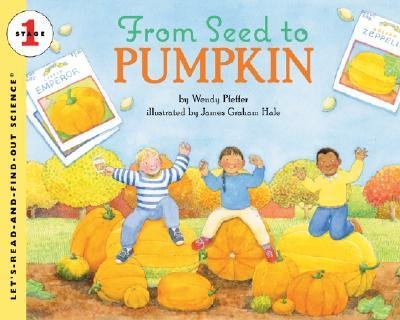From Seed to Pumpkin is a great story that will answer kids questions about where pumpkins come from and it integrates science with a seasonal theme. The story begins with the farmer planting seeds in the spring and takes you through an entire year of the life of a pumpkin. Throughout the story there are explanations describing how the seeds are growing and what the needs of the plant are. It explains how flowers bloom on the vines and after they wither away they turn into tiny fruits that begin to grow. The book also explains some uses of pumpkins as jack-o’-lanterns and for pumpkin pie for fall holidays. At the end of the story it is spring again and the farmer is out planting more pumpkin seeds. This book will give children a great understanding of the needs of plants and how they grow throughout the seasons of the year.
Curriculum Connections:
This book is a great tool to use for a unit on plants and living things, pumpkins or Halloween. It discusses the needs of plants(air, water, light, place to grow) and the parts of the plant(seed, stem, roots, leaves, stem, flower buds). For Virginia, this covers Life Processes SOLs K.6 and 1.4.
Additional Resources:
- First School has a good worksheet students can practice the letter P and sequences with a pumpkin unit.
- Busy Teacher Cafe has a great pumpkin unit and different ways you can use pumpkins in math, science, and writing. It has ideas for bulletin boards, crafts, and even some pumpkin poems.
- The Pumpkin Circle has a great informational page that discusses lots of questions about pumpkins from how to grow then to when should they be picked.
- Education World has a good lesson for predictions with pumpkins where kids get to count the seeds of different size pumpkins and then graph the results.
Title: From Seed to Pumpkin
Author: Wendy Pfeffer
Publisher: Harper Collins Publishers
Publication Date: 2004
Pages: 33
Grade Range: K-1st
ISBN:9780064451901

